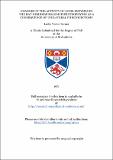Files in this item
Changes in the activity of some enzymes in the rat hemidiaphragm hypertrophying as a consequence of unilateral phrenicectomy
Item metadata
| dc.contributor.advisor | Tristram, George Roland | |
| dc.contributor.author | Turner, Leslie Victor | |
| dc.coverage.spatial | 320 p. | en_US |
| dc.date.accessioned | 2018-07-03T09:45:48Z | |
| dc.date.available | 2018-07-03T09:45:48Z | |
| dc.date.issued | 1971 | |
| dc.identifier.uri | https://hdl.handle.net/10023/14831 | |
| dc.description.abstract | The post-denervation hypertrophy of the rat hemidiaphragm has been studied for up to 15 days after nerve section. The denervated tissue increases in wet weight to a maximum at 5 days of 40 % over its initial weight; by the 15th day the tissue has atrophied to below the control value. Measurements have been made throughout the hypertrophy period of the activities of some enzymes characteristic of particular aspects of muscle metabolism. In additions concentrations of glycogen from fed, and overnight fasted rats; of myoglobin; and of free amino acid concentrations in the denervated tissue have also been studied. Methods are described for the use in rats of the anaesthetic Halothane so as to preserve muscle glycogen concentrations and to prevent stress-mediated activation of phosphorylase a levels. Unilateral phrenicectomy causes a decrease in glycogen concentration and contents a decrease of total glycogen phosphorylase activity is also found, but total content of phosphoglucorautase increases slightly, Hexokinase and phosphorylase contents increase so that their concentrations are maintained. The validity of the hexokinase/ phosphorylase ratio as an indicator of fibre composition in pathological tissues is questioned. Phosphohexoisomerase activity remains constant for 1 week after denervation, then decreases, but glyceraldehyde phosphate dehydrogenase & lactate dehydrogenase demonstrate increased contents at 7 days before they decrease; the responses of the dehydrogenases may be related to the reported proliferation of the sarcoplasmic reticulum. No significant change is observed in the lactate dehydrogenase isoenzyme proportions until 7 days when a decrease of H-type subunits is indicated; 3 days later though control proportions are regained. Content of malate dehydrogenase, VAD-, & NADP-specific dehydro-genases demonstrate rapid decreases after nerve section to roughly half the initial levels at 3 days after nerve section. Glutamate dehydrogenase concentration also decreases in the early stages of the hypertrophy, but later increases when protein catabolism becomes a significant process. These decreases art in 'accord with the reported fragmentation of the mitochondria. Glucose G-phosphate dehydrogenase and 6-phosphogluconate dehydrogenase concentrations increase dramatically to a peak within the first few days after nerve section. The increased enzyme capacity could be responsible for provision of nentose phosphates for nucleotide and nucleic acid synthesis. Total creatine kinase activity remains constant for up to 5 days before a decline in observed; adenylate kinase & adenylate deaminase show increased contents. The responses are interpreted in terms of possible involvement in increased adenine nucleotide production. The validity of the adenylate kinase/creatine kinase activity- ratio for the identification of physiologically distinct muscles in questioned. Content of glutathione reductase shows two small peaks of increased activity at 3 and 10 days after denervation. Thus unlike other denervated or dystrophic muscles, the responses o NADP-linked dehydrogenoses are not similar. Myoglobin content increases slowly during the hypertrophy only reaching a peak of 20 % over control levels at 10 days. Concentration in the early stages is thus decreased but rises after 5 days. The response, as well as the changes in lactate dehydrogenase isoenzyme proportions, is interpreted in terms of an increased blood flow through the denervated tissue. Total free amino acid concentration in the denervated tissue is increased; responses of the individual species are interpreted in terms of possible modes of metabolism in the tissue. The responses in the denervated hemidiaphragm are interpreted in terms of a hypertrophy of the "red" &/or "intermediate" fibre types; suggestions are made as to possible causes for the responses. | en_US |
| dc.language.iso | en | en_US |
| dc.publisher | University of St Andrews | |
| dc.subject.lcc | QP190.T8 | |
| dc.subject.lcsh | Secretion | en |
| dc.title | Changes in the activity of some enzymes in the rat hemidiaphragm hypertrophying as a consequence of unilateral phrenicectomy | en_US |
| dc.type | Thesis | en_US |
| dc.contributor.sponsor | Medical Research Council (MRC) | en_US |
| dc.type.qualificationlevel | Doctoral | en_US |
| dc.type.qualificationname | PhD Doctor of Philosophy | en_US |
| dc.publisher.institution | The University of St Andrews | en_US |
This item appears in the following Collection(s)
Items in the St Andrews Research Repository are protected by copyright, with all rights reserved, unless otherwise indicated.

